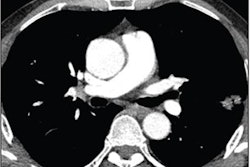Patients with distant recurrent non-small cell lung cancer (NSCLC) detected on low-dose CT (LDCT) have better overall survival compared with those with de novo disease, researchers have found.
The study results may help "inform future clinical trial designs to ensure a balance for baseline patient characteristics," wrote a team led by Chloe Su of Stanford University. The findings were published September 26 in JAMA Network Open.
Treatment for lung cancer has advanced, but the disease "still poses a therapeutic challenge," and survival outcomes of patients with metastatic disease by type (de novo stage IV versus distant recurrence) aren't well understood, according to the investigators.
"It is notable that most major clinical trials for advanced lung cancer have not distinguished between these two types of metastatic disease for lung cancer, even though prior literature has suggested a significantly higher overall survival among those with recurrence," they wrote.
The team sought to assess individuals' overall survival after diagnosis of metastatic disease via a study that included data from 840 patients, of which 660 (primary cohort) came from the National Lung Screening Trial (NLST) (enrolled between 2002 and 2004 and followed for seven years) and of which 180 came from Stanford Healthcare (data from between 2009 and 2019, followed for 13 years). Study participants were categorized by those with distant recurrent NSCLC or de novo metastatic diagnoses; most were white.
The authors found the following:
- Patients with distant lung cancer recurrence had better overall survival rates than those with de novo metastasis, with an adjusted hazard ratio of 0.72 (with 1 as reference) in the NLST group and 0.64 in the SHC group.
- In the SHC cohort, patients with de novo metastasis more frequently experienced progression of the disease to the bone or pleura (52.5% and 33.3%, respectively) compared to those with distant recurrence (31.7% and 13.3%, respectively).
- Also in the SHC cohort, patients with distant recurrence were mainly identified through symptoms (85%) rather than post-treatment surveillance (78.3%)
The study findings may have significant clinical repercussions, they wrote.
"The potential drivers of this differential survival outcome could be attributed to the earlier detection of metastatic disease among patients with distant recurrence through CT surveillance, tumor burden, and metastasis to the pleura and bone," they concluded. "This factor associated with outcomes may have important implications in future clinical trials and cost-effectiveness analyses, and the treatment effectiveness for patients with metastatic NSCLC warrants further evaluation.
The complete study can be found here.




















